This is a time for paying attention to rebirth.
I have been noticing lone female Elk and Pronghorn quite a bit in the past week and a half. With both species being herd animals, especially the females, this tips us off that they are separating from the group to give birth. You would think that a cow Elk would not want to give up the benefit of extra sets of eyes, ears, and noses to sense predators that a herd provides, however, the good thing about spreading out across Grand Teton National Park is that predators will find some of the calves, but not all of them. It’s a bit of a dilution effect.

The last few days, I have been seeing juvenile Uinta Ground Squirrels just coming out of natal dens for the first time this year across the Valley’s Sagebrush Grasslands habitat. They seem to come out of the den with an unwary idealism that makes them very susceptible to predators. Even meat-eaters that are not skilled hunters (such as ravens) of live mammal prey, can catch the juveniles. The timing is perfect for meeting the caloric needs of red-tailed chicks, badger cubs, and fox kits. It only takes about a week before the Ground Squirrel young sharpen their senses and become realists.
Want to be the first to know what Kevin notices next? Or when new wildlife tours are launching? Sign up for our Wildlife Expeditions newsletter, Fresh Tracks, to receive the latest wildlife news, exclusive tour discounts, and more!

Last week, I had the pleasure of witnessing four Black-billed Magpies fledge from their very cryptic stick nest in a Douglas-fir out behind my house. Like the Uinta Ground Squirrels, the fledgling birds clearly still had a lot to learn, including how to fly more than just short distances. But I knew they’d be expert opportunists in a short time. That Magpie nest is new this year, and I don’t think it’s a coincidence that the Mountain Blue Bird pair that starting building a nest in one of my backyard nest boxes opted not to risk nesting so close to the nest predator Magpies. Magpies cannot readily get into a nest box, but a few years ago, I observed one killing a Mountain Bluebird that had just emerged from a nest. Since the Bluebirds didn’t stay this summer, a pair of Tree Swallows moved into their nest box, and House Wrens took over the nest box that the Tree Swallows usually use. Interesting ripple effects of the new Magpie residents. Perhaps fledgling Tree Swallows and House Wrens are more equipped to evade Magpies.
Let’s not forget about the insects. I know that anglers have been paying plenty of attention to the hatching of aquatic insects from rivers and creeks, but I welcome back the Mosquitoes. Seriously, hatching Mosquitoes are another significant sign for me that another winter has come and gone, and there is so much good and hope and life in this ecosystem.

And how about the plants? This may be the peak of the wildflower display on the Jackson Hole valley floor. Flowering Biscuitroot, Lupines, Larkspur, and Arrowleaf Balsamroot are ubiquitous. The pale yellow flowers blanketing the Antelope Bitterbrush (one of the favorite foods of Moose) make me smile and question the second half of its name.
-Kevin Taylor


